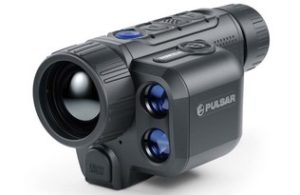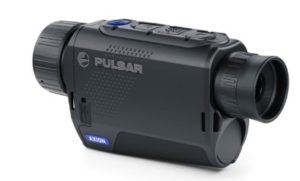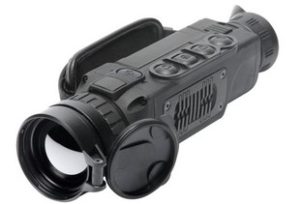Looking for the Best Pulsar Thermal Monocular? You have come to the right place.
A thermal monocular is a valuable tool to have for hunting, surveillance, military missions, and other applications. A thermal monocular will help you see targets with excellent clarity regardless of the lighting or weather condition.
Besides that, monoculars are easy to use and easy to carry wherever you go.
Pulsar is one of the best Thermal Monocular brands on the market.
Why Pulsar Thermal Monoculars
- High Definition Thermal Sensors for the best images even in extreme conditions and terrains
- Long detection range up in complete darkness
- Large aperture lenses for the ultimate detection efficiency
- Strong, durable, and lightweight magnesium alloy housing
- Full-color HD AMOLED display
- Variable Magnification
- Built-in Photo and Video Recorder
- Wi-Fi. Integration with IOS and Android devices
- Waterproof performance
- Wide Range of Operating Temperatures
- User-friendly interface
Best Pulsar Thermal Monocular-Our Top Picks
1) Pulsar Helion 2 XP50 2.5-20 Thermal Monocular
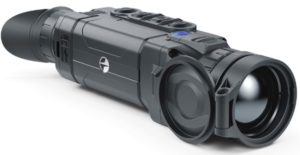
The Pulsar Helion 2 XP50 is your ideal thermal monoculars if you are looking to take your nighttime viewing to the next big level.
It is an all-around thermal optic suitable for hunting, surveillance, and search & rescue missions among others.
The monocular is built ready for rugged outdoor use. It has an IPX7 waterproof rating and a frog-resistant AMOLED display. It is also built to be fog resistant to ensure that it offers flawless performance in extreme temperature and humidity conditions.
Furthermore, the thermal monocular boasts a 50 Hz refresh rate which provides quick updates of targets.
In typical nighttime environments, it provides an effective detection range of 2,000 yards and has 8 color palettes that you can use to get the best views of targets in different light settings.
The other essential features this monocular brings to the table are long battery life, a stadiametric rangefinder, and a lightweight design that maximizes mobility convenience.
Features
- 1800m detection range
- 640×480 pix. @ 17 µm (NETD <40 mK) sensor
- 2.5x magnification
- Operating temperature range of -25 to +50° C (-13° F to +122° F)
- Germanium lenses
- All-metal, light-alloy body
- Water, fog, and dustproof
- Functional and ergonomic design
- Image Detail Boost technology
- 12.4×9.3 / 21.8×16.3-Field of view (HxV), degrees / m@100m
- A highly sensitive thermal imaging sensor
- 3m minimum focus
- 50Hz refresh rate
- 10 hours of battery life
- Stadiametric rangefinder
Pros
- Multiple color palettes
- Lightweight design
- User-friendly interface
- Versatility
- iOS and Android compatible
- Wi-Fi remote control
- Multipurpose (security, hunting, terrain orientation, observation, search and
rescue operations)
Cons
- Wi-Fi and built-in video recorder use consistent will shorten battery life
2) Pulsar Helion 2 XP50 Pro 2.5-20 Thermal Monocular
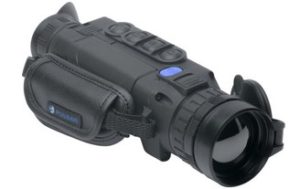
This Pulsar Helion 2 XP50 Pro is the best Pulsar Thermal Monocular for hunting.
It features a stadiametric rangefinder with a known height of 1.7 m (deer), 0.7m (wild boar), and 0.3 m (rabbit).
It is built with high-end technology and cutting-edge features to help you take your hunting, surveillance, and observation a notch higher.
It detects heat signatures up to 2,000 yards and will offer crisp views of targets under any lighting and environmental conditions.
With the variable 2.5-20x magnification, you can use the monocular to locate targets at close to long ranges.
To complement the broad zoom range, the optic also comes with a large 50mm objective lens which provides the much-required wide field of view.
The monocular also features 4 observation modes and 8 color palettes for greater versatility.
Furthermore, this device boasts premium-quality Germanium optics that provide clear and tack-sharp sight pictures.
It has a rugged housing that optimizes durability and you can use it in any weather condition as it is fully waterproof.
The monocular provides up to 8 hours of continuous use to keep you in the field for as long as you want.
Features
- 1800m detection range
- 12.4×9.3 / 21.8×16.3-Field of view (HxV), degrees / m@100m
- 640×480 @ 17 µm (NETD <25 mK) sensor
- Image boost technology
- 8 hrs battery life
- Variable digital zoom
- IPX7 Waterproof Rated
- -25 to +50°C operating temperature
- Updatable Software
- 16GB internal memory
- Stadiametric rangefinder with a known height of 1.7 m (deer), 0.7m (wild boar), and 0.3 m (rabbit)
- Picture-in-picture mode
- IPX7 water resistance rating
- Quality Germanium optics
- HD AMOLED display
- Built-in photo and video recorder
Pros
- Ultralight design
- Excellent fit and finish
- Interchangeable batteries
- Multiple accessories included
- User-friendly interface
- Wi-Fi. Integration with IOS and Android devices
- Built-in Photo and Video Recorder
- 2.5х-20x Variable Magnification
- Large aperture lens
- Structural strength and resistance with an Ultra-high-strength magnesium alloy housing
- Full-color HD AMOLED display
Cons
- The reception range is dependent on Wi-Fi networks and obstacles
3) Pulsar Helion 2 XQ50 Thermal Monocular
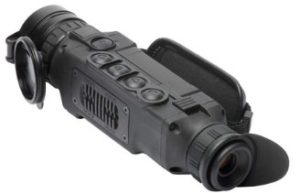
This all-around monocular provides a detection range up to 2000 yards/1800m and is ideal for hunting, surveillance, and search and rescue missions.
With this monocular, you are guaranteed flawless performance under any light settings.
It is operable under a wide range of temperatures from -13 to 122℉. It is also fog proof, dust proof, and water resistant for operability under any weather condition.
For added convenience, the monocular boasts a lightweight and compact design that fits perfectly in the palm of your hand.
It also features a user-friendly interface and ergonomic button locations for easy access.
Other essential features that make this monocular a valuable asset are an accelerometer, stadiametric rangefinder, Wi-Fi connectivity, and a convenient carrying case.
Features
- 1800m detection range
- 384×288 pix. @ 17 µm (NETD <40 mK) sensor
- 4.5-18x magnification
- 50Hz refresh rate
- IPX-7 water resistant rating
- Frost-resistant AMOLED display
- Built-in video recorder
- 8 hours of battery life
- 50 Hz refresh rate
- 7.5×5.6 / 13х9.8-Field of view (HxV), degrees / m@100m
- IOS and Android Wi-Fi integration
- External Power Supply
- Manual, Semi-Automatic, Automatic calibration modes
- Large aperture lens
- 4 operating modes: Forest, Rocks, Identification, User
- Amazing imaging even in adverse weather conditions (fog, smog, rain)
- Stadiametric Rangefinder with known height (deer – 1,7 m; boar – 0,7 m; hare – 0,3 m)
Pros
- Long 2000 yards detection range
- Night and day use
- Lightweight and compact design
- Highly Sensitive Thermal Imaging Sensor
- Ultra-easy user interface
- Crisp clear image views with Full-color HD AMOLED display
- Strong and durable magnesium alloy housing
- Wide range of operation temperatures–25 to +50° C (-13° F to +122° F)
Cons
- The PS14 battery Pack is bought separately
4) Pulsar 2-8x Axion 2 XQ35 Thermal Monocular
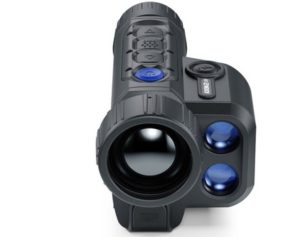
Pulsar 2-8x Axion 2 XQ35 Thermal Monocular has a powerful 384×288 sensor that detects heat signatures of targets that are as far as 1400 yards/1300m.
It features a variable 2-8x magnification suitable for glassing targets at close to medium ranges.
This monocular is lightweight for mobility convenience. It also features a compact design so you can take it anywhere you want.
Construction-wise, it features reinforced magnesium alloy housing that is IPX7 water resistant for operability under any weather condition.
Furthermore, the monocular boasts a pristine AMOLED display that provides crisp clear image views of targets.
It is powered by a high-capacity battery that provides up to 11 hours of continuous run time.
The monocular comes with a built-in photo and video recording feature to help you capture every single moment of your hunting trip.
Features
- 1300m detection range
- 2-8x magnification range
- x4 zoom
- F35/1.0 Objective lens
- 10.7х8 / 18.2-Field of view (HxV), degrees / m@100m
- 384×288 pix. @ 17 µm sensor
- 11 hours of battery life
- Germanium lens material
- Multi-coated optics
- 640x400p AMOLED display
- IPX7 water resistant rating
- Built-in photo and video recording
- Enhanced image processing algorithms
- High-quality, durable, reinforced, and strong magnesium alloy housing
- Fast aperture F35/1.0 lens
- Built-in photo and video recorder. Free 16 GB cloud space
Pros
- Multiple color palettes (8)
- 5 seconds Fast start-up
- Lightweight and portable design
- Robust and reliable construction
- Fully Waterproof
- Wi-Fi connectivity
Cons
- Short eye relief (4mm/ 0.16inch)
Other Pulsar Thermal Monoculars to Consider
| Pulsar Axion 2 LRF XG35 2.5×20 Thermal Monocular
|
|
| Pulsar Axion 2 XG35 2.5×20 Thermal Monocular
|
|
| Pulsar Axion XM30F 3-12x Thermal Monocular
|
|
| Pulsar Helion 2 XQ38 Thermal Monocular
|
|
Where are Pulsar Thermal Monoculars Made?
PULSAR devices are designed, developed, manufactured, packed, and sent out to our worldwide distributors from Europe.
Choosing the Best Pulsar Thermal Monocular
When you are shopping for the best Pulsar thermal monocular, here are some of the most important factors you should take into consideration.
Resolution
If you are buying a thermal monocular for the first time, you are probably wondering what the resolution is. First, there are two types of resolutions in thermal imaging monocular, thermal resolution, and screen resolution.
The former shows you the amount of energy the monocular can detect from a certain distance, while the latter represents the number of pixels the monocular uses to form the image.
A thermal resolution of 320×240 pixels is sufficient for most applications while a screen resolution of 1280×720 pixels is considered the best for virtually any application.
Field of View
The field of view a thermal monocular provides is crucial as it determines how far you will be able to see.
The wider the field of view, the larger the area you will be able to see at a time.
This translates to quick target finding and swift tracking of a fast-moving game.
Detection Range
The other important feature you should consider is the detection range.
This is the maximum distance the monoculars can detect the presence of a heat-emitting object. Pulsar thermal monocular has different detection ranges. Determine how far you intend to pursue targets and then choose a unit that offers the appropriate detection range.
Build Quality
No matter the application you purpose to use the thermal monocular for, ensure that it is built with premium quality materials that optimize durability.
Some thermal monoculars are shockproof to stand up to rough handling and they are the best. The monocular should also be waterproof, fog proof, and dustproof to offer reliable performance under any weather condition.
Battery Life
The battery life of a thermal monocular is another important factor to consider. If you intend to use the monocular for a lengthy period of time, ensure that you pick a unit that has long battery life.
For optimal performance, the battery should provide at least 8 hours of non-stop runtime.
Operating Temperatures
It is also important that you take into account the operating temperatures the monocular boasts.
When you are out there in the field, the weather can change when you least expect it. Typically, you will find that thermal monoculars are designed to operate in temperatures ranging from -20°C to 50°C which is ideal for most applications.
Additional Features
It will be an added advantage if you pick a unit that offers extra features at no extra cost.
The more features the thermal monocular has, the more versatile and functional it will be.
Some of the extra features you should look out for are built-in Wi-Fi that allows you to transfer data from the monocular to your smartphone or computer, built-in video record, a smart range finder, and night vision among others.
Best Pulsar Thermal Monocular FAQs
- How far can you see with a thermal monocular?
This will depend on the monocular you are using, the quality of optics, and how sensitive the thermal sensor is. In most cases, the detection range varies from one unit to the other, with the high-end models offering a detection range that is as far as 2000 yards or even more.
- Why are thermal monoculars so expensive?
Thermal monoculars fetch a higher price tag compared to traditional monoculars because of the high-end technology they incorporate. They also boast a wide variety of top-notch features which add to the cost.
Conclusion
Thermal monoculars are ideal for use in different fields. With their versatility, the best Pulsar thermal monocular will largely depend on what you intend to use it for, your budget, and individual preference.
Regardless of the model you end up choosing, it is our hope that this detailed post has helped point you in the right direction. Whatever you have in mind, there is a thermal monocular out there waiting for you.
Related

